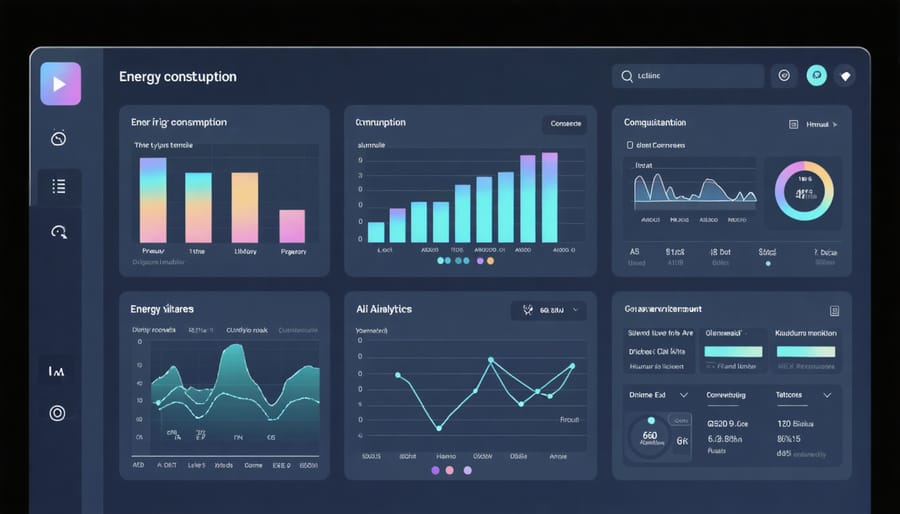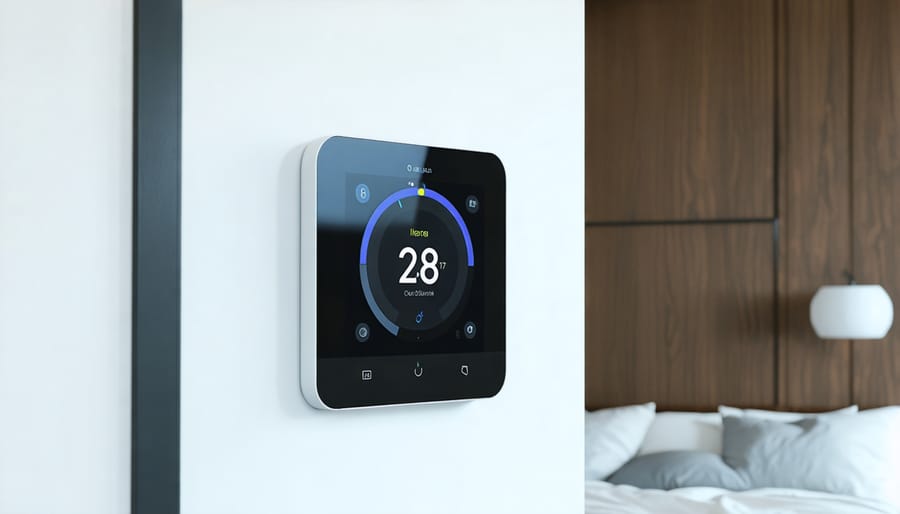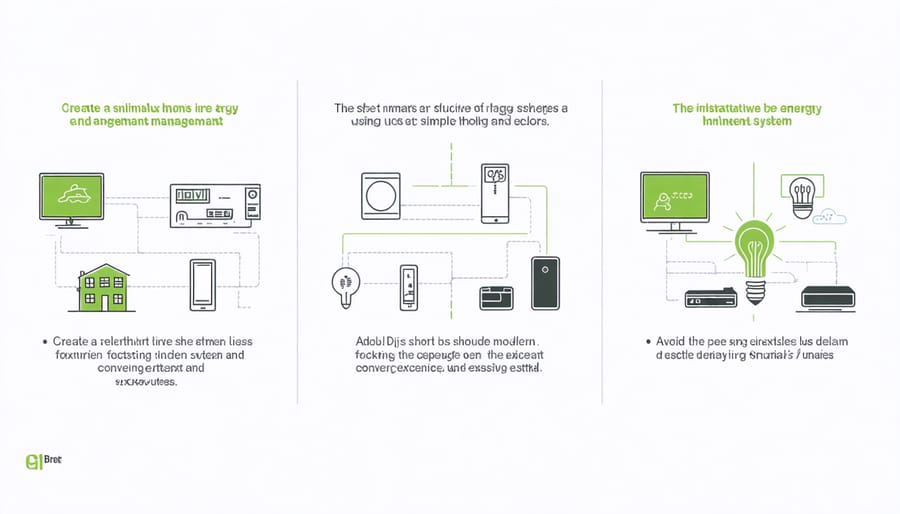Transform your home into an energy-efficient smart haven with AI-driven technology that’s revolutionizing how we reduce energy consumption and manage our living spaces. Today’s artificial intelligence solutions analyze real-time data from smart thermostats, lighting systems, and appliances to automatically optimize your home’s energy usage while maintaining perfect comfort levels.
Unlike traditional programmable systems, AI-powered home automation learns your family’s patterns and preferences, making intelligent adjustments that can slash utility bills by up to 30% without sacrificing convenience. These smart systems detect when rooms are occupied, predict weather changes, and even factor in electricity pricing variations to make cost-effective decisions on your behalf.
The beauty of modern AI home technology lies in its accessibility – you don’t need to be tech-savvy to benefit from its capabilities. With user-friendly apps and intuitive interfaces, homeowners can easily monitor and adjust their energy usage while letting artificial intelligence handle the complex calculations and daily optimization tasks. Whether you’re starting small with a smart thermostat or implementing a comprehensive home energy management system, AI-driven solutions offer practical, measurable benefits for every household.
How AI Makes Your Home Energy-Smart

Real-Time Energy Monitoring
Imagine having a smart assistant that watches over your home’s energy use 24/7, spotting patterns and making adjustments in real-time. That’s exactly what AI-powered energy monitoring systems do. These intelligent systems use advanced sensors throughout your home to track electricity consumption from various appliances and systems, creating a detailed picture of your energy usage habits.
The AI analyzes this data continuously, learning when you typically run your dishwasher, how long you take showers, and even which rooms you use most frequently. This creates a personalized energy profile for your household, helping identify energy-wasting patterns you might not notice yourself.
What makes this technology particularly clever is its ability to adapt and predict. It can forecast your energy needs based on factors like weather conditions, time of day, and your usual routines. When it spots unusual energy spikes or inefficient usage patterns, it sends immediate alerts to your smartphone, suggesting ways to optimize consumption. Some systems even automatically adjust settings on smart devices to maintain comfort while reducing waste, like dimming lights in empty rooms or tweaking your thermostat based on occupancy patterns.
Predictive Usage Analysis
Think of AI as your home’s energy fortune teller – it’s constantly learning from your daily routines to better predict when and how much energy you’ll need. By analyzing your historical energy usage patterns, AI can anticipate your needs before you even think about them. For example, it notices that you typically turn up the heat around 6 AM on weekdays, so it starts warming your home just before you wake up.
This smart technology doesn’t just look at your usage patterns; it also factors in weather forecasts, seasonal changes, and even special events like holidays. If you regularly host Sunday family dinners, the AI will recognize the increased energy usage during these times and adjust accordingly.
What makes this particularly useful is how it helps you avoid energy waste and unexpected spikes in consumption. The system learns which rooms you use most frequently and when, automatically adjusting temperature and lighting to match your lifestyle. Over time, these predictions become increasingly accurate, leading to better energy management and lower utility bills – all while maintaining your comfort preferences.
Rather than reacting to energy needs as they arise, AI stays one step ahead, making your home truly smart and efficient.
Smart Features That Cut Your Energy Bills

Automated Temperature Control
Today’s automated temperature control systems are revolutionizing how we manage our home’s climate. Using artificial intelligence, these smart systems learn your temperature preferences and daily routines to create the perfect indoor environment while minimizing energy waste.
Instead of relying on rigid schedules, AI analyzes multiple factors like outdoor weather, room occupancy, and your past temperature adjustments to make intelligent heating and cooling decisions. The system might, for example, start cooling your bedroom an hour before bedtime on warm nights or reduce heating in rooms that aren’t being used.
What’s particularly impressive is how these systems adapt over time. They can predict when you’ll return home from work, account for seasonal changes, and even factor in energy prices to run your HVAC system when rates are lowest. Many homeowners report saving 15-30% on their energy bills after switching to AI-controlled temperature management.
The best part? Once set up, these systems work quietly in the background, requiring minimal input while keeping you comfortable year-round. They can even send alerts about maintenance needs or unusual energy usage patterns, helping you stay on top of your home’s climate control.
Smart Appliance Management
Imagine your washing machine starting at the perfect time to take advantage of off-peak energy rates, or your dishwasher automatically running when solar power production is at its peak. This is the reality of modern smart appliance integration, powered by artificial intelligence.
AI-driven appliance management works by analyzing your household’s energy usage patterns, local utility rates, and even weather forecasts to optimize when and how your appliances operate. Your smart thermostat learns your schedule and adjusts temperatures accordingly, while your refrigerator can fine-tune its cooling cycles to minimize energy consumption during peak hours.
The system can orchestrate multiple appliances simultaneously, ensuring they don’t all draw power at once, which could strain your electrical system or result in higher bills. For example, your EV charger might pause briefly while your dryer finishes its cycle, then resume once power demand decreases.
What makes this technology truly remarkable is its ability to learn and adapt. Over time, the AI becomes more efficient at predicting your needs and adjusting operations accordingly, potentially saving you hundreds on annual energy costs while maintaining your comfort and convenience.
Peak Usage Optimization
AI-powered energy management systems are revolutionizing how we handle peak usage periods, potentially saving you hundreds on your utility bills. These smart systems learn your household’s energy patterns and automatically adjust your power consumption during expensive peak rate hours.
Think of it as having a super-smart energy assistant that knows exactly when electricity costs the most. The AI predicts these peak periods and takes proactive steps to reduce your consumption during these times. For example, it might pre-cool your home before peak afternoon rates kick in, or automatically shift your dishwasher’s start time to run during cheaper off-peak hours.
What makes this technology particularly clever is its ability to balance comfort with cost savings. Rather than making dramatic changes that might disrupt your routine, the AI makes subtle adjustments throughout the day. It might slightly adjust your thermostat, coordinate your smart appliances’ run times, or manage your EV charging schedule to avoid peak rates.
The best part? Once set up, these systems work silently in the background, requiring no daily input from you while consistently delivering savings on your energy bills.
Setting Up Your AI Energy System

Choosing the Right System
When it comes to selecting smart energy management solutions, it’s essential to find a system that matches your specific needs and home setup. Start by assessing your current energy usage patterns and identifying your main goals – whether that’s reducing electricity bills, optimizing heating and cooling, or managing solar power integration.
Consider the size of your living space and the number of zones you want to control. For smaller apartments, a basic AI thermostat with learning capabilities might suffice. Larger homes may benefit from a more comprehensive system that manages multiple zones and integrates with various appliances.
Look for systems that offer user-friendly interfaces and mobile apps that match your tech comfort level. The best AI solutions should provide clear, actionable insights without requiring an engineering degree to understand them.
Compatibility is crucial – ensure the system works with your existing HVAC equipment and other smart devices. Many homeowners find success with platforms that support popular protocols like WiFi, Zigbee, or Z-Wave.
Don’t forget to factor in your budget, including both initial costs and potential long-term savings. While premium systems offer more features, mid-range options often provide excellent value for most households. Consider starting with core functions and expanding as needed, rather than investing in features you might never use.
Installation and Integration Tips
Setting up AI-driven technology in your home doesn’t have to be complicated. Here’s your friendly guide to getting started:
First, assess your home’s compatibility. Most modern smart homes can easily integrate AI systems through your existing Wi-Fi network. Start by ensuring you have a stable internet connection and a compatible smart hub if required.
Begin with the basics:
1. Download the recommended AI management app on your smartphone
2. Create your user account and connect to your home network
3. Install any necessary smart sensors in key areas of your home
4. Connect your smart devices one at a time, following the app’s prompts
5. Test each connection before moving to the next device
Pro tip: Place sensors away from heat sources and direct sunlight for accurate readings. For optimal performance, position your hub centrally in your home.
When integrating with existing systems:
– Start with one room or system (like lighting or heating)
– Gradually expand as you become comfortable
– Use the app’s guided setup wizard
– Take advantage of automatic device discovery features
– Save your settings as you go
Remember to regularly update your system’s software when prompted. This ensures you’re getting the latest features and security improvements. If you run into trouble, most AI platforms offer helpful troubleshooting guides and customer support.
Take time to familiarize yourself with basic commands and automation rules before diving into advanced features. This approach helps build confidence and ensures a smoother integration process.
Making the Most of Your AI Energy Assistant
Customization Strategies
Getting your AI-driven technology to work perfectly for your lifestyle doesn’t have to be complicated. Start by establishing your daily routines and preferences – when you wake up, your preferred temperatures throughout the day, and when you typically return home. Most smart home AI systems come with user-friendly apps that let you input these patterns with just a few taps.
Consider creating different profiles for weekdays and weekends, as your schedule likely varies. For instance, you might want your home cooler during workday evenings when you’re exercising but warmer during lazy Sunday mornings. Pay attention to your household members’ preferences too – some AI systems allow multiple user profiles, ensuring everyone’s comfort.
Take advantage of the learning period most AI systems offer. During the first few weeks, provide feedback through the app about your comfort levels and any adjustments you make. This helps the AI understand your preferences better. Don’t forget to set up alerts for unusual patterns or potential issues – this can help you catch problems early and save on energy costs.
Start with basic settings and gradually explore more advanced features as you become comfortable. Many systems allow you to integrate with other smart home devices, creating a more comprehensive automated environment. Remember, the goal is to make technology work for you, not the other way around.
Monitoring and Maintenance
Keeping your AI-driven home technology running smoothly doesn’t have to be complicated. Start by checking your system’s performance metrics weekly through the companion app or dashboard. Look for any unusual patterns in energy usage or unexpected changes in device behavior.
Regular software updates are crucial for optimal performance. Enable automatic updates whenever possible, but make sure to review what’s new in each update. These often include important security patches and new features that can enhance your system’s efficiency.
Create a monthly maintenance schedule to check all connected devices. Ensure sensors are clean and unobstructed, smart thermostats are responding correctly, and all devices are properly connected to your home network. If you notice any devices frequently disconnecting, it might be time to upgrade your Wi-Fi router or adjust device placement.
Back up your system settings and automation rules regularly. While AI systems are generally reliable, having a backup ensures you won’t lose your carefully crafted preferences if something goes wrong.
Set up automated alerts for potential issues like unusual energy consumption patterns or device malfunctions. This proactive approach helps you address problems before they impact your home’s efficiency.
Don’t forget to periodically review and adjust your automation rules based on seasonal changes and your family’s evolving needs. The beauty of AI-driven systems is their ability to learn and adapt, but they still benefit from your input and fine-tuning.
As we’ve explored throughout this article, AI-driven energy management solutions represent a game-changing opportunity for homeowners looking to create smarter, more efficient living spaces. By implementing these intelligent systems, you can expect to see significant reductions in your energy bills while enjoying enhanced comfort and convenience in your home.
The benefits are clear: automated temperature adjustments that learn from your preferences, real-time energy usage monitoring that helps you make informed decisions, and predictive maintenance alerts that prevent costly repairs. Best of all, these systems continue to improve over time, becoming more attuned to your household’s unique patterns and needs.
Getting started with AI energy management doesn’t have to be overwhelming. Begin with a smart thermostat and gradually expand your system as you become more comfortable with the technology. Many homeowners find that the initial investment pays for itself through energy savings within the first year or two of use.
Remember, every small step toward smarter energy management makes a difference – not just for your wallet, but for our planet too. As these technologies become more accessible and user-friendly, there’s never been a better time to embrace the future of home energy management. Take that first step today, and join the growing community of homeowners who are using AI to create more sustainable, comfortable, and efficient homes.
